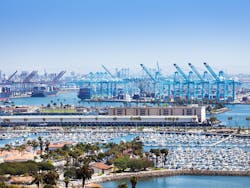Long Beach, Calif., Urges Regulatory Reforms to Overcome Microgrid Delays
Pointing to delays in getting a microgrid built, the city of Long Beach, California, is urging state regulators to make changes to speed up the process.
The city is focused on two issues: utility rules governing power supply to separate premises and the California Public Utilities Commission’s interconnection rules.
Long Beach’s concerns were raised in response to microgrid proposals released last month by Pacific Gas & Electric (PG&E), Southern California Edison (SCE) and San Diego Gas & Electric (SDG&E).
The proposals are driven by a new law (S.B. 1339) that seeks to spur microgrid development in the state. The PUC in December divided its microgrid proceeding (R.19-09-009) into two tracks and directed utilities to file microgrid plans that could be put in place by September 1, ahead of the upcoming wildfire season to reduce the effects of public safety power shutoffs — planned power outages designed to reduce fire risks.
Long Beach is developing a microgrid at its 3,200-acre port. The project is set to be installed at the port’s Joint Command and Control Center, which manages the port’s response and surveillance operations, according to the city’s Jan. 30 filing at the PUC. The microgrid will be linked to the Jacobsen Pilot Service, which brings ships into the harbor.
Microgrid hurdles
The port two years ago awarded Schneider Electric a $5.2 million contract to build the project, which includes a solar array, battery storage and diesel generator.
The project ran into “significant difficulties” due to SCE’s Rule 18, which bars microgrid operators from selling electricity from energy storage units because the stored electricity might include electricity received from the utility, according to Long Beach.
The snag hinged on the supply of electricity from the port to the Jacobsen Pilot Service. The PUC in May granted SCE a waiver from its Rule 18 so the port can provide power to the pilot service when the microgrid is separated from the utility’s system.
“The problem was eventually overcome through an ad hoc method but needs to be promptly addressed on a more global basis,” Long Beach said.
The city also called for improving the PUC’s interconnection regulation, called Rule 21, to ensure “prompt and economic” interconnections with microgrids.
Join us June 1 in Philadelphia for a special Microgrid 2020 pre-conference workshop on policy and regulation.
“Experience already obtained indicates that regulatory reform such as changes to Rule 18 and Rule 21 reform is necessary to the widespread development of microgrids in California,” Long Beach told the state regulators.
As part of a set of proposed short-term actions the PUC can take to support the rapid deployment of microgrids, agency staff is proposing to require utilities work with stakeholders to develop template-based application processes for Rule 21 non-export storage, net energy metering resources paired with storage, and net energy metering solar.
Staff also recommends changes to reduce delays caused by utility site inspection requirements. The utilities, for example, should eliminate inspections that duplicate ones conducted by local jurisdictions, according to the staff proposal.
What causes delays
In its comments to the PUC, the Clean Coalition said the staff’s interconnection reform proposals are “no-brainers” that should be adopted.
The non-profit microgrid developer also noted that delays do not typically occur in the application review process but after an interconnection agreement has been completed “as interconnection applications bounce between utility departments for final engineering, confirmation of deposits, service planning and construction scheduling.”
The delay occurs, in part, because distributed energy resource interconnection requests are given lower priority than urgent needs of existing customers, the Clean Coalition said.
We invite you to download, “Why Energy-as-a-Service Microgrids are the Logical Next Step for California…and the Rest of the U.S,” free of charge, courtesy of AlphaStruxure. And we encourage you to share this link widely to help educate California — and the rest of the U.S. — about energy-as-a-service microgrids.







